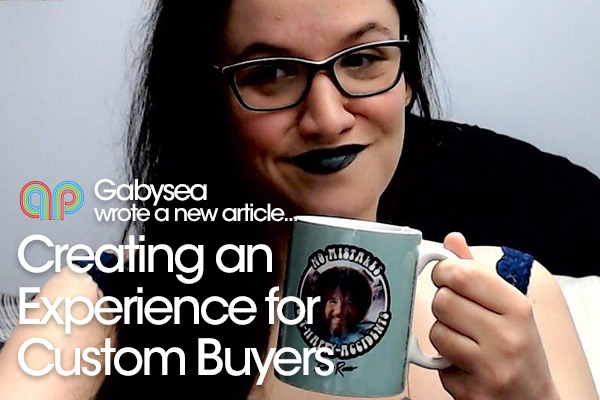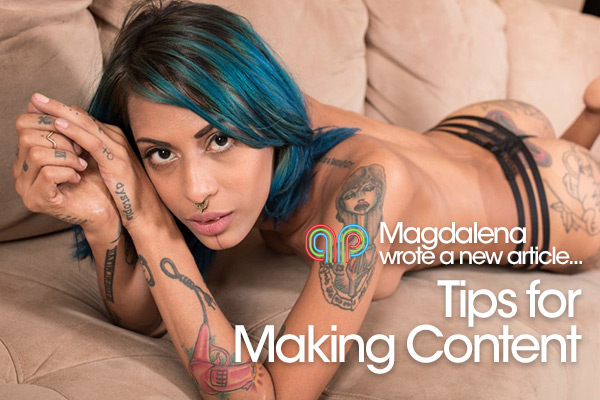Filming and Editing Tips by Lily LaLoca
These are some tips and tricks I’ve learned during my 6 years of streaming and content creating. I’ve had the opportunity of having some of my content professionally filmed by Adult Indie Productions, a production company ran by Jolene Brody, an adult streamer and content creator, and honestly one of my biggest inspirations and mentors in the industry. A good amount of my advice I learned through my experiences of working with Jolene and her production company. Before working with them, the only videos I ever filmed were recordings of my live cam shows. I only knew how to entertain a live audience, I had never entertained an audience that wasn’t directly in front of me. This provided some challenges when being filmed for the first time, but I was really lucky to be working with such great people willing to teach and guide me into being myself. Not everyone is as lucky as I was, and hopefully some of the things I’ve learned can help.
I think one of the biggest and basic pieces of advice I have learned is to film when you feel good. Film as much as you can fit into your schedule without sacrificing balance. If you film as much as you can while you feel your best, you will have plenty of content ready to edit for when you aren’t able to film, aren’t feeling well, need to take time off, or even when you’re lacking the inspiration to create new content.
Film within your comfort zone. This can pertain to the obvious things like the wardrobe you wear or the type of play performed, but it can also pertain to other things. For example, I rarely stand in videos, I just flourish a lot better when I have a surface to move and roll around on. I found this out when trying to film my first video with Adult Indie Productions. I started standing up and when the camera started rolling, I literally just stood there and couldn’t even fathom how to begin! We talked and brainstormed and they asked me if I would be more comfortable starting on the floor, and it all took off from there.
Know your comfort zones, for the big things AND the little things.
While filming, unless you’re shooting a voyeur style video, you generally want to interact with the viewer and make it feel like they are there with you. Pretend the camera is a person and the lens is the person’s eyes, when you want to have eye contact with your viewer, look into the lens, engage with it the way you would a person. If you want to flirt with your viewer, flirt with the lens. It isn’t necessarily to hold eye contact the entire time though! Taking breaks from too much eye contact can prevent it from feeling like a stare down!
While engaging with the camera lens, one thing that I always remember is “sleepy eyes”. The sultry, soft, sexy eyes that we see everywhere in and outside of the adult industry. I have practiced this look many times by starting with my eyes closed and slowly opening them about halfway, not fully. Similar to a squint feeling, but without the scrunching of your face. Try to focus on keeping your face muscles relaxed while doing this. It takes a lot of practice, but when you get the hang of it, you’ll know how to snap in and out of the look pretty fast.
I highly recommend against looking at your display screen while filming, I know it’s right on the camera and it seems like it won’t be noticeable in the video where you look, but you can generally tell when a model is looking into the camera, or at a display screen. I have caught myself doing this SO many times. I know it can be so tempting while filming to keep checking the display screen to see if everything is in frame, but if you know your filming space, you should easily be able to keep yourself within frame without having to constantly check. I’d even recommend closing your display screen while filming to avoid this all together. If you do need to check that you’re in frame, be sure to complete any current action or phrase you are saying before checking your display. You don’t want to be flirting with the camera while looking in a slightly different direction halfway through your sentence.
If you realize you suddenly need to “cut” during a take, try pausing in your current position before cutting. This usually helps me with finding a smooth cut/transition between the two takes while editing later. For example, if I’m in the middle of playing with myself and really need to get some water, I will finish what I am doing/saying, pause in that position for a couple seconds and then cut. As opposed to if I am playing with myself and up the second I am thirsty without having a pause, sometimes the actions blur together and it can be hard to find a good place to cut later!
Film more than you need. I tend to film AT LEAST a full hour or TWO for every video I make. Most of my finished videos average around 15 minutes, but I have videos over 30 minutes long, as well. Most of my older videos are shorter, as I wasn’t familiar with this technique.
Try to film more than one angle if you can, it not only provides more depth to your video, but also provides much smoother cuts and transitions when there are several angles to cut to and from. That’s how “movie magic” happens. For example, removing a shirt is always so awkward. Showing the full action can sometimes be awkward and unnecessary, but quick cuts from different angles can let the viewer perceive the action of taking off the shirt, without seeing the full action in awkward nature. Videos filmed with one angle are still wonderful and you can still make some smooth movie magic if you’re mindful about cuts and transitions!
Speaking of movie magic, cuts and transitions… always cut on a moving action. For example, if I am cutting from full body to close up of my boobs, start with a full body shot of my hands moving up my stomach to my boobs, and cut to a close up of my boobs where my hands are moving in the same direction upward. The continuous motion makes it feel more natural for the viewer. When cutting from one take to the next, the focal point should stay in the same general spot on the screen. For example, in a full body shot of me touching my boobs, let’s say I’m placed on the right side of the frame, when I cut to the close up, I am grabbing my boob on the left side of the frame, the viewers eyes will have to shift from focusing on the right side of the screen to the left, which makes it less natural and easy on the eyes when viewing. If I cut to a close up where I am grabbing my boob on the right side of the frame, the viewers eyes can simply stay focused where they are, making it easier and more natural to perceive what’s happening.
Sometimes when trying to get more than one angle, I will film with two cameras at once, for more fluidity between cuts and takes. This is great because any of my full body actions are also filmed at the same time on a different camera for a close up angle. However, when I do this, I tend to have more variables to try to maintain under control. One camera will pick up light differently and I will have to match up the coloring the best I can. One camera will record at a slightly different pace, so even after syncing up the separate footage once, I usually have to re-sync the footage several times during editing because one camera records faster.
I personally don’t mind the extra work because I love the fluidity in the end result, where full body shots and close up shots have matching actions and just flow directly into one another.
Always test everything! Before you begin filming, always do a test take, or several. During your test take, I recommend trying out all the positions you plan on being in during tour film. Different positions can yield different results for the following tests. First, test your lighting! Is it too bright? Too dark? Your lighting may look good when you’re behind the camera, but when you get in front of the camera, does the light wash you out? Are you having any shadow effects that you don’t want? Does your lighting shift when you move or switch positions? These are all signs that your lighting might need adjusting.
If lighting in your test take looks as you want it, move on to the next variable. Test your sound! There are several ways I test my sound, I usually test my voice at normal talking level, when I talk softer, spank myself, and when I moan. I do this to make sure my microphone is picking up sounds of all levels, that way my quieter sounds won’t be missed. Testing my sound from the different positions I will be in is also helpful. Sometimes different positions place your face closer or further from the microphone which can produce different sound levels. Whether you use an external microphone or one built into your camera, it’s good to test your sound.
Once you’re content with your sound levels, move on. One of the most important things is to test and check the focus on your camera! I’ve had full footage end up out of focus because I didn’t test the shot appropriately to start with, or when I did test, the footage looked fine on the small display screen of my camera, but realized it was out of focus when I transferred it to my computer. If I would have watched the test footage on my camera display screen but instead zoomed in on different spots of the take to see how the focus was, I probably could have avoided it the entire mishap.
This is especially true when filming bath or shower videos. Firstly, I always recommend using water as cold as as you can tolerate it because steam and cameras are not friends. But no matter how many precautions you take, no matter how many times you test, I would still recommended checking your footage several times during filming sessions for shower and bath videos. In my experience, minor issues with sound and lighting can sometimes be fixed in editing, but out of focus footage is just that, out of focus.
If possible, take small breaks during filming to:
- Check footage periodically, sometimes my cameras stop filming and I don’t hear the “beep” and I keep going and don’t realize all the footage I lost until I finish. This happens even more so with bath/shower videos, as previously stated, and I find it’s best to take even more breaks while filming these videos to check your footage. That way, if something goes wrong, you won’t have to scrap or re-film an entire new video, you will only have to re-film from when you last cut and checked your footage.
- Drink water and stay hydrated.
- Rest your body from hard positions or being stationary in position. Stretch when needed.
- Lube up if necessary.
- Change memory cards/batteries/etc.
- Go to the bathroom if needed (watch out for toilet paper left behind though!)
- Pep talk yourself or pat yourself on the back. Creating art can be hard work!
When editing, try to:
- Line up your footage in order of how you want it to flow. For example, in a typical video, I will line up my footage as follows:
- Clothed full body
- Clothed close ups
- Naked full body
- Naked close ups
- Masturbation full body
- Masturbation close ups
Because I that’s the order of how I will cut them together, generally speaking.
Sometimes I will do a more scattered type of editing style, where the clips aren’t chronologically fluid, but fluid in another manner, like music videos. Most music videos can tell a story, without every clip moving in chronological order. But even with this style of editing, you still want to remember crucial things like making sure you’re still cutting on similar actions and movements so the clips can still flow together.
Be proud of everything you produce and release everything. Everything! Unless there is something technologically wrong with the footage, almost everything can be used in some way. We are our own best critics and our own worst enemies in that respect. Generally speaking, someone is bound to like what you’ve created. You can always price things accordingly, if you a video didn’t turn out the way you want, don’t scrap it, just price it accordingly to what you think it’s worth! I spent 2 hours filming a bath video and one of the angles I filmed from was in and out of focus the whole time. I didn’t scrap the video. I used what footage I could and I knocked the price down because the video didn’t come out quite like I wanted. Turns out I got one of my best compliments from that video. If you really don’t like how footage turned out all together, save it and cut up the footage you DO like and use it as promotion clips! Don’t limit yourself because something didn’t turn out as planned, adapt and use it to your benefit. And most of all, just be you. The advice I give are merely things that I have learned that help me. It doesn’t mean this is THE way to do it, this is just A way to do it.
This article was written for us by Lily Laloca, if you’d like to contribute to the AP Lounge, please get in touch via email.



